I’ve been wanting to walk the pilgrim’s path to Santiago de la Compostella for decades. This is the most famous Christian pilgrimage in the world, dating from before the 8th century, a peregrination to reach the relics of St James the Apostle (or Sant Iago in Spanish).
St James was one of the first followers of Jesus and, a decade after the cruxificion, was executed by beheading in Jerusalem. The story of his remains ending up in Spain hundreds of years after his death seems unlikely. Nevertheless he is the patron saint of Spain, represented by the russet cross and the scallop. Compostella means ‘field of stars’ or the milky way.
There are several routes: a network of paths from England, Italy, Portugal and France, all joining together at Santiago. You can see the emblem of St James, a bronze cast of the shell, embedded in pavements, along the way. I’ve spotted them in Vezelay and Bordeaux for instance. The original pilgrimage, the Camino Primitivo, runs from Oviedo in Asturias; the Camino Ingles/English Way from A Coruna; the Camino Del Norte is the oldest route, running from the Basque region parallel to the northern coast of Spain. Due to the season I was walking, I chose the Camino Frances.
To qualify for a pilgrim’s certificate, there is a minimum walking distance of 100 kilometres and two stamps a day in your ‘passport’ which you can obtain at shops, bars and hotels. Booking via Caminoways.com, who arrange accommodation and luggage transfers, the walk from Sarria to Santiago on the Camino Frances/French way is 120kms over five days. I gaped nervously at the distances, between 25 and 35 kms a day. After discussion with Camino Ways my journey was extended to nine days, meaning I would walk between ten and 20 kilometres a day. This I could cope with. Just.
Preparation:
I did some research on what to wear before I went.
Protecting your feet from blisters was vital. I bought a job lot of Compeed blister plasters. Consider buying extra comfy insoles too.
Shoes or boots:
I had three possibilities; a pair of Timberlands or pair of Hi-Tech boots that my mum gave me; or Skechers trainers. I wore each of them for several days, around the house and on long treks along the Thames Path. The Timblerlands were way too heavy. My legs were tired just wearing them, never mind the walking. The Hi-Tech boots were uneven, perhaps worn out. The most comfortable were the trainers so I decided to wear them.
On the trail, my scarcely worn Skechers literally fell apart by the second day, so I bought Spanish hiking boots, Chiruca ‘Troll’ for about £100. (If I’d bought them beforehand they’d only have cost me £60 but it is good to know you can buy anything you need on the Camino). They were lightweight (256g), waterproof and had easy laces with a stopper. What I didn’t realise, although it might sound obvious, is that one must have them loose enough on the feet to allow your blood to circulate but tight enough on the ankle to give support. For a couple of days my feet were in agony because my boots were laced up too tight. I never regretted investing in these boots as the weather got pretty dicey. Buy your boots in a size too big.
In summer you will need hiking sandals such as these. And socks. It doesn’t matter how naff you look, you wanna save those feet.
Socks: I read that you must wear two pairs of socks, thin then thick, to prevent rubbing and that they must be made of Merino wool. So I bought these and these. Then I discovered, on the trail, the existence of anti-blister socks, so I ended up wearing them with the thick pair of Merino wool socks. (How do anti-blister socks work? The inside is coated with a polymer to stop rubbing, the outer fabric wicks moisture away.) Cotton is the worst thing to wear for blister prevention. I didn’t get one blister.
Take an extra pair of comfy shoes, I took Fit Flop ballet flats, for the evening. You’ll be desperate to change shoes at the end of the day. Fit Flop soles are a new discovery for me, and they are a comfort revelation. Hard to wear anything else now.
Walking sticks: you are going to need one or two sticks, for going downhill, for navigating uneven ground, to support your knees and spread the weight. You can go the romantic and traditional wooden pilgrim hook (which can be bought on the trail for between 6 and 10 euros). Or you can invest in Nordic walking sticks. I got these Tekrite Women’s Antishock Hiking sticks for £20.
Headwear: I bought an ingenious beanie hat with an LED light on the front, for dark mornings and shuffling around in a shared room without waking everyone.
You may also want to invest in a waxed rain hat with a brim. You will look like Liam Gallagher but it’ll keep the rain off your face and glasses.
Rain gear: you are going to need this. The Galician part of the camino always rains. I wore two raincoats: a fold-up rain jacket, rain trousers and a nylon poncho. I still got a bit wet, the rain came in from all directions. The poncho is essential to cover your pack and in my case, my massive Canon 6d camera that I carried the whole bloody way. I wore the rain over-trousers every day. If you have a bit more money then invest in some Gore-tex.
Every morning it felt as if one was preparing for a space walk or skiing- rustling tiers of clothing, stomping about in boots.
Clothes:
Wear layers.
Lightweight merino wool sweater from Mountain Warehouse
3 T-shirts
3 pairs trousers/leggings. No jeans.
Pyjamas or nightie.
A couple of dresses to go out to dinner or for arrival in Santiago.
Pair of tights if winter.
3 pairs of socks.
A puffa jacket. These Uniqlo ones are good and lightweight. I bought the Primark version in Camino yellow. I did think about my colour combos and went for yellow and blue. Think of the selfies.
I always take at least half the number of knickers for the days I’m going away – so five pairs. Every few nights I’ll have a little knicker washing session in the hotel sink and hang them over the radiator.
Two bras/bra-lettes/sports bras.
Toiletries:
Makeup. I wore full makeup every day. I’m not even kidding. Someone called me the lipstick pilgrim. Foundation protects your skin. Buy one with sunscreen. Take a primer, mascara, eyeliner and lipstick (Mac Matte is my go to).
Toilet paper: for between stops on the trail.
Wipes: for taking off makeup.
Hair brush/conditioner. Most hotels have shampoo and soap but few have conditioner. You can tell they are designed by men.
Sun screen.
Lipsalve/balm.
Zinc nappy rash cream. Sudocrem. I got a really sore ‘chefs’ bum and this helped.
Tiger Balm. I always have this in my travel medical pack. So many uses: muscle relaxant, unblocking bunged up noses, to rub on temples in case of headache.
Painkillers. Take anti-inflammatory ones like Ibuprofen. These were essential after a couple of days. My legs hurt so much I needed them to go to sleep.
Sundries:
Waterproof wallet/pocket on a lanyard to hang around your neck for your camino passport and your phone. I bought a crappy one on the trail which didn’t last long. You are going to be whipping out your phone for pictures all the time. You will also need easy access to your camino passport to get the stamps (in bars, restaurants, shops, hotels). If you don’t have the stamps, you have no proof you did the trail. No proof, no pilgrim’s certificate at the end with your name in Latin. Also the stamps (sellos) are fun – each has a different design.
Next time I’d also take a frontal fanny pack for camera, money, credit card, lip salve, toilet paper.
Water bottle. Absolutely essential. Make sure you have easy access to it. My water bottle was hanging off my backpack and hard to reach. This meant I didn’t drink enough water. As it was raining most of the time, I didn’t feel thirsty. This was a mistake. You still sweat in the rain although you are less aware of it. It affected my performance. In hot weather I would definitely invest in a rehydration system. You are going to need constant water.
For autumn/winter, my sister took a hot water canister and tea bags. This one doubles up as a water bottle. Lodgings or cafes along the way filled it up with boiling water – a cup of hot tea on the trail really made a difference.
The Walk:
Galicia is basically Spanish Wales, with similar wet weather and vivid green landscapes.
Doing the camino in November, it rained every day; I wore two raincoats and was still soaked – at times it felt like I was living the grim in ‘pilgrim’.
But I inhabited the season as never before: under a glowering sky I saw giant pumpkins in fields, fairy-tale red/white spotted mushrooms, bronze ferns, slate churches, auburn and amber leaves, sheep in rusty forests, long-horned red cattle, purple crocuses, mustard lichen, rainbows reflected in puddles, streams and mossy bridges. And of course crosses everywhere; sometimes made from twigs by pilgrims and threaded through wire fences, sometimes tucked with commemorative photos of loved ones, sometimes discretely pinned to trees.
Daily Routine:
Wake at 7.30, climb into layers and boots.
Breakfast at 8am.
Walk for six or seven hours. When the weather gets really bad, stop for a coffee.
Arrive at the hotel/boarding house at around 3pm. Lunch in Spain is late, so this was in time for the Menu del Dia or the Pilgrim’s Menu which is virtually identical every day:
A typical 10 euro Pilgrim’s Menu includes bread (great dark sourdough hunks) and wine, a bottle each.
I drank all of my wine, the entire bottle, mainly to dull the pain but also as a gift, an alcoholic pat on the back, to myself.
Then I’d go back to the room, get in bed and fall asleep.
I was asleep by 7pm every night, sometimes earlier. Occasionally I sprung for a massage in my room. Not gonna lie, I was in fucking agony. I’m a wimp, I thought. I’m even more unfit than I thought. My self-esteem sank.
The Food:
The food is hearty damp climate fare: caldos (soups), seafood and fish, chestnut and bean stews, great local wines and Torta de Santiago, an almond citrus tart (recipe below).
Most pilgrim’s menus consist of:
Soup (Caldo Gallego) or salad
Hake and potatoes or a meat dish.
Pudding: either tarta de queso or Torta de Santiago.
If you are vegan or vegetarian, there is not much to eat. The soup, which I craved after a damp day’s walking, always had a meat stock. There is occasionally Porrusalda, a leek and potato Galician soup. (I will occasionally eat a piece of fish when travelling, but to eat fish every day feels like protein overload.)
I had planned to write daily. I imagined scribbling poetic treatises on nature, the essence of autumn, deeper thoughts on reality, prayer, mindfulness, who am I, what am I and all that palaver. Reader, I was too exhausted. Instead I only had the energy to file a few Instastories which I used as a visual diary. Not for me the carefully curated and filtered lifestyle pix with artful selfies. Nope. Instead smudged rainy pictures and pale-faced self-portraits attesting to the fact that I barely coped.
At one point I had a row with my sister. I was slowly staggering up a hill and when I reached the top, she wiped tears from her eyes while looking at me piteously: ‘You are doing so well. It’s so hard for you. But you are continuing’.
Patronising cow I thought but I bit it back. When I seemed less than pleased by her comment, she said archly: ‘You don’t take a compliment very well’. My sister thinks crying makes her look like a nice person.
I seethed inside. Who wants pity? And of course I will continue. That’s what I do. I never give up. This is my trip and she’s just a companion. Of course I’m going to do it, even if it kills me. I’m not known for my faint-heartedness whatever my faults. I’m a soldier. I carry on. It shocked me that it even occurred to her that I’d give up.
It also pissed me off that she dieted on the camino. It’s a thing that often happens between women – diet wars – when the one that is eating the least wins. It’s a subtle psychological battle. We were doing plenty of exercise, no need to fast while on the trip.
But apart from that we got on fine. We both snored. She had more energy than me and wanted to go out in the evening. I just couldn’t.
The Way:
The way itself is clear: the yellow shell and arrow on a background of blue tile is at every junction, it’s impossible to get lost, if you follow the path. I only got lost once, when I decided to take a ‘short cut’. Hollow laughter.
Arrival at Santiago airport, then taxi to Sarria (this was included in the Caminoways.com package). You can get the bus but it’s a bit of a pfaff.
First night: Arrive Sarria.
Stay at 3* Alfonso hotel in Sarria, an old fashioned but elegant Spanish hotel. Dinner in the bar/restaurant. A quick mosey outside revealed murals and my first sight of the camino, a steep hill paved with stone.
Day 1: 15 kms to Casa Morgade.
A mostly sunny walk with the odd light shower to Casa Morgade and one of my two favourite places to stay on route, a cosy inn with a roaring fire and a friendly owner. The countryside is stunning, I can’t stop taking photos. I can do this!
Day 2: 17 kms to Portomarin.
Spotted giant pumpkins in fields and sprawling over walls. Finally a long bridge over the river to Portomarin, a 3* hotel, Pousada de Portomarin which has a large bedroom, but an unhelpful reception. They insisted on seeing my passport before checking me in and it was in the bottom of my suitcase. I was too exhausted to move. I asked if I could check in and bring down the passport later, I’ve never known a hotel to refuse this. But the heartless woman at the reception did. She’s obviously never walked the camino.
In the town there is a lovely church, community centre, friendly local restaurants and an outside stall selling BBQ octopus. Here I had to buy aforementioned new boots, wondrous blister socks and bright red rain cape.
Day 3: 13 km to Ventas de Naron.
Walk to Ventas de Naron, a small hamlet called O’Cruceiro Ventas. During this season many inns have shut down. This one was basic but friendly. But I’m starting to hurt badly. It’s very wet and cold.
Day 4: 12 km to Palas de Rei.
Walk to Palas de Rei, Complejo la Cabana 3*, a nice wooden cabin style hotel. But had an incident. My sister and I were talking quietly around 10pm and next door started banging violently on the wall, screaming at us in Spanish. At first we were frightened and shocked to hear angry male voices and one woman. In the morning I went to the breakfast room and asked who was next door to us. A furious looking woman said proudly that it was her. Then she and her husband became abusive in Spanish. In my best Spanish I said ‘you aren’t pilgrims’, ‘you don’t have the spirit’.
Day 5: 14 km to Melide.
Walk to Melide, a modern town, where we stayed at Hotel Carlos 96. The owner lived in the UK for a while and speaks excellent English. Nice restaurant.
I’m hobbling about. We had a massage in our room in the evening. It’s the consecutiveness of it all that is getting to me. One of my favourite masochistic behaviours was to look on Google maps how long it would have taken by car: generally 30 minutes but 6/7 hours walking.
Day 6: 14 km to Arzua.
Walk to Arzua which was arduous. A long long high street, seemingly never ending. Nice shops that I didn’t have the energy to visit. Our lodging was Casa Brandariz, slightly outside the town, where they pick you up. This is a beautiful guest house with a huge fireplace where legs of ham are smoking. Too tired to eat dinner, just a plate of cheese and a whole bottle of wine but breakfast was great. This was my second favourite lodging.
I woke early to ferocious rain, and see my sister in the dawn light, writing out her diary. Then we’d put ‘Bright side of the road’ on by Van Morrison, who became our musical travel companion. We’d practise our ‘norn ireland’ accents and wonder what it was like to be married to Van.
Day 7: 18 km to Rua-Pedrouzo

Chupitos 
This was the most difficult day, weather-wise. It was raining very hard which turned to hail. Most days I was fine for the first ten kilometres then gradually became worn-down and sodden. We lost our way towards the end which added to our kilometres. In the restaurant/bar of our hotel Rural Acivro, we got drunk on ‘chupitos’ Spanish shots. Anything to kill the pain!
Day 8: 10 kms to Lavacolla
Staggering along. Lost my phone twice on the way. My sister kindly went back to find it. One of the shorter days, just 10km but I’m really pushing myself now. The last couple of kilometres to the hotel seem endless. The hotel, Ruta Jacobea 3*, is a large business-style hotel. The restaurant is closed so we walk in more rain to the village where we have a good meal. We watch The Way on Netflix. Lavacolla is where pilgrims would wash themselves before entering Santiago.
Day 9: 10 kms and Arrival in Santiago


Rainbow over Santiago
Arriving in Santiago itself, the pain was worth it. Galician bagpipes hummed outside the cathedral. It didn’t matter how slow I was, I’d made it, a real sense of achievement. We opened a mini bottle of Cava we got from breakfast at the hotel and I shook it up Formula One style, which was probably a bit heretical.
We stayed at the utilitarian Hotel Gelmirez 3*. In retrospect I would have sprung for something posher and more atmospheric. Opposite the cathedral is Parador de Santiago de Compostella, with a bar and shell carpet. We went there for drinks though.
We queued up to get our pilgrims certificate in a special office off the main square. I’m going to frame it when I get home. This year was a record year for pilgrims, around 300,000 walked the route. For the second year running there were more females than men. Solo females: do it.
Aftermath
It took me two weeks to recover. I enjoyed eating and drinking around Santiago, meeting up with fellow pilgrims at bars (I’ll do another post on this). Poorr Nathan, the charming hair transplant Australian, broke his foot and so could not complete the camino. He was limping about in some kind of plaster boot.
In general this pilgrimage taught me that the youngest and fastest don’t always make it – it’s a case of the tortoise and the hare. ‘Chi va piano, va sano e va lontano‘, an Italian phrase which means the equivalent of ‘slow and steady wins the race’ was something I repeated to myself all along the route. It taught me to go at my own pace even though it might be embarrassingly slow.
Two days later I got the plane home to London and spent two straight days in bed. In fact I spent most of the week in bed. I was broken but did feel fitter. Stairs were easier. But I want to do it again. I can’t wait to go back.
The Pilgrims:
The pilgrims themselves, dementor-like in rain capes, hunched over their loads and walking sticks, came for vastly different reasons: if not religious then for contemplation and thoughts about their futures.
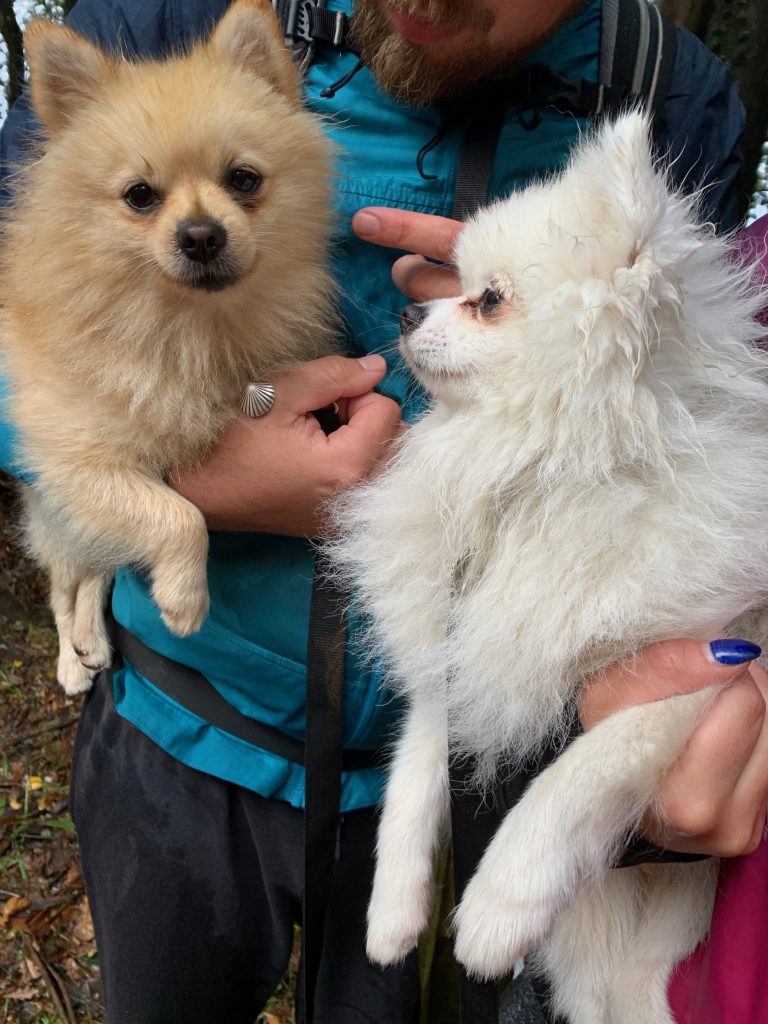
These dogs are stars 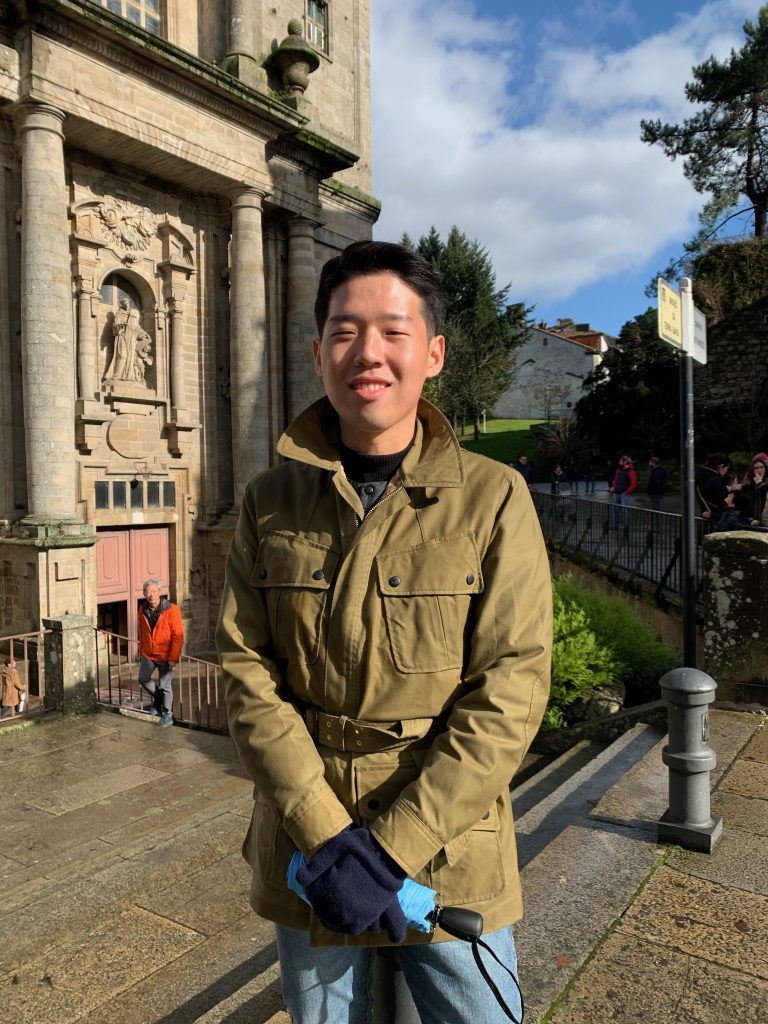
He came to prove he could be on his own 
Two Canadian girls that bought bear spray 

Hardy American solo woman 
Kid who found it annoyingly easy 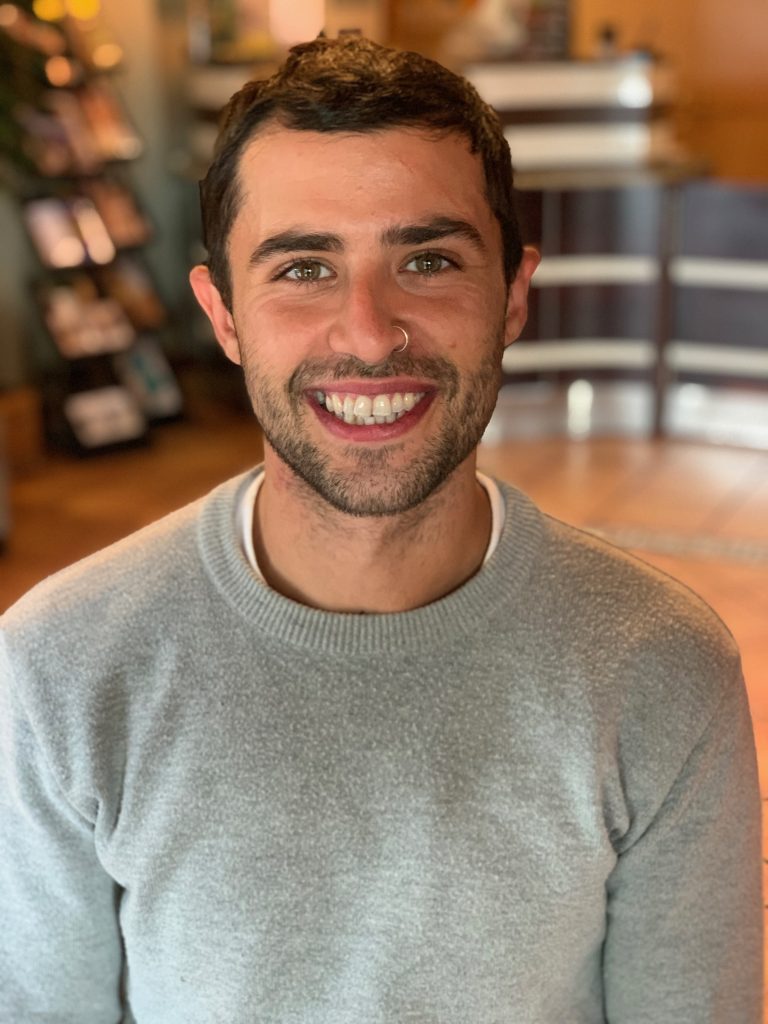
Good looking Nathan from Australia had a hair transplant 
Latvian boy not sure if he wanted to get married 
Jacques-Michel from Brittany 
We are scared said these two 
Swedish Angenette -empty nester 
Works in IT and wants to change career
I met characters along the way: lone hardy women striding through the hail with bare legs, shorts and boots; an Australian lesbian couple ‘locals are a bit shocked when we ask for a double matrimonio bed’; Swedish Angenette, an empty-nester wondering what to do now; 72 year old Jacques-Michel who’d spent 3 months walking from Brittany; Edvard, 21, from Latvia, unsure if he wants to get married when he returns home; 29 year old Nathan from Australia who has just had a hair transplant in Istanbul ‘because I’m still good looking’; girls from Canada who brought bear spray(!); a long-limbed yoga teacher from the States who was recently divorced.
I was surprised at the amount of Koreans doing the trip: I was told that it was a career move, ‘you can network on the camino, that’s why we all have the best hiking gear, to impress people’. But I bit back the tears as one Korean young man told me his mother was dying at home ‘I did the walk to prove to myself that I can be alone’.

The pilgrim’s service on Sunday 

Recipe for Torta De Santiago
Ingredients
- 6 egg yolks
- 250 g caster sugar
- 250 g almond flour
- Zest of 2 citrus, lemon, orange, bergamot, whatever is in season
- 2 tbsps of orange flower water
- 1 tsp cinnamon
- 6 egg whites, whisked to soft peaks
- Icing sugar to decorate
Instructions
- Preheat the oven to 170ºC
- Whisk the yolks and sugar together.
- Add the rest of the ingredients except the egg whites.
- Whisk the egg whites into soft peaks
- Fold the whites gently into the mixture.
- Pour into the tart tin and bake for 35 minutes.
- Remove from the oven and let it cool.
- Place the cross on top and dust the tart with icing sugar. Remove the cross and serve.
- Will last a week.




Horreos or store houses for grain



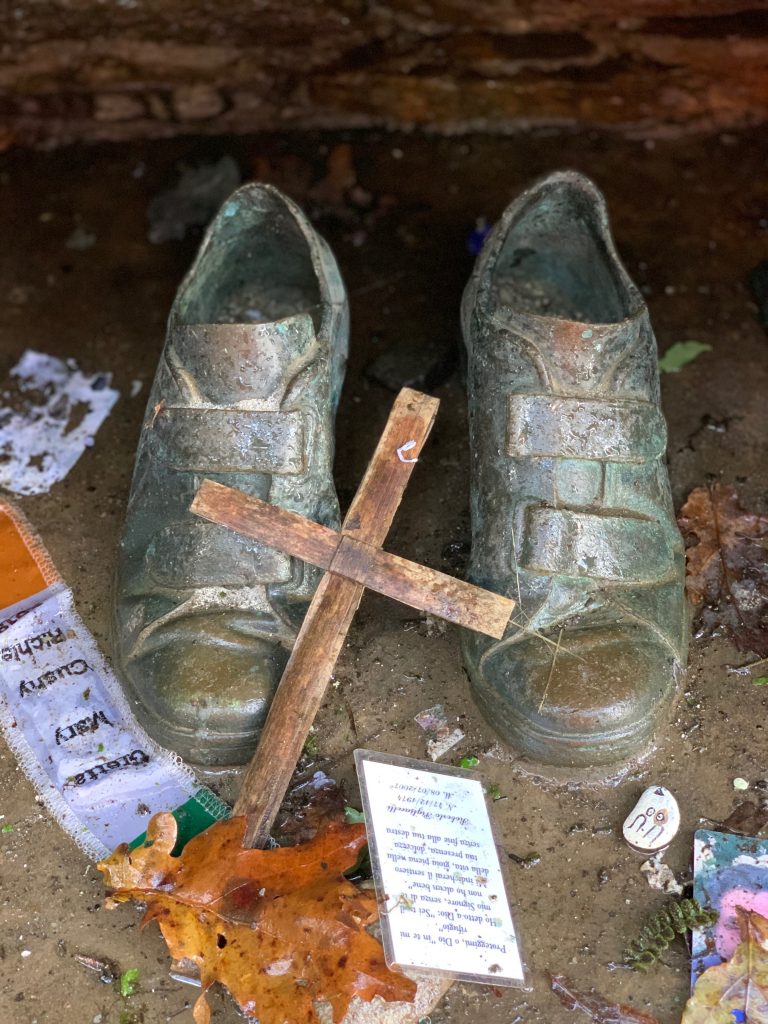









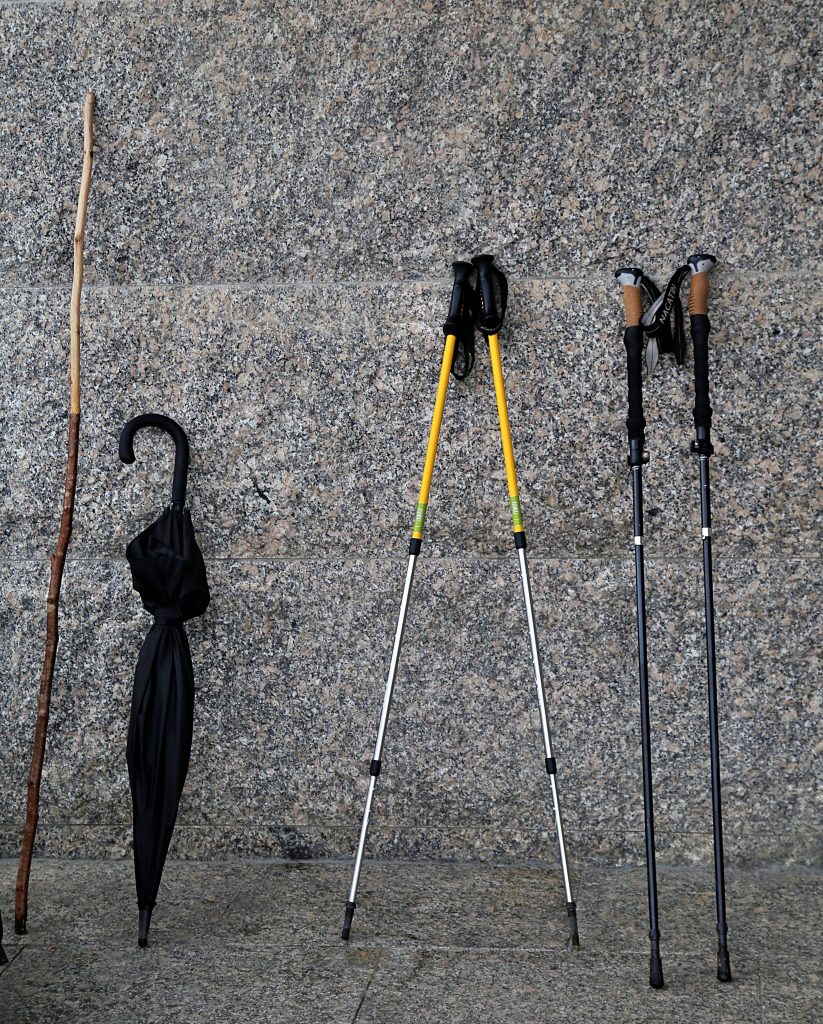






















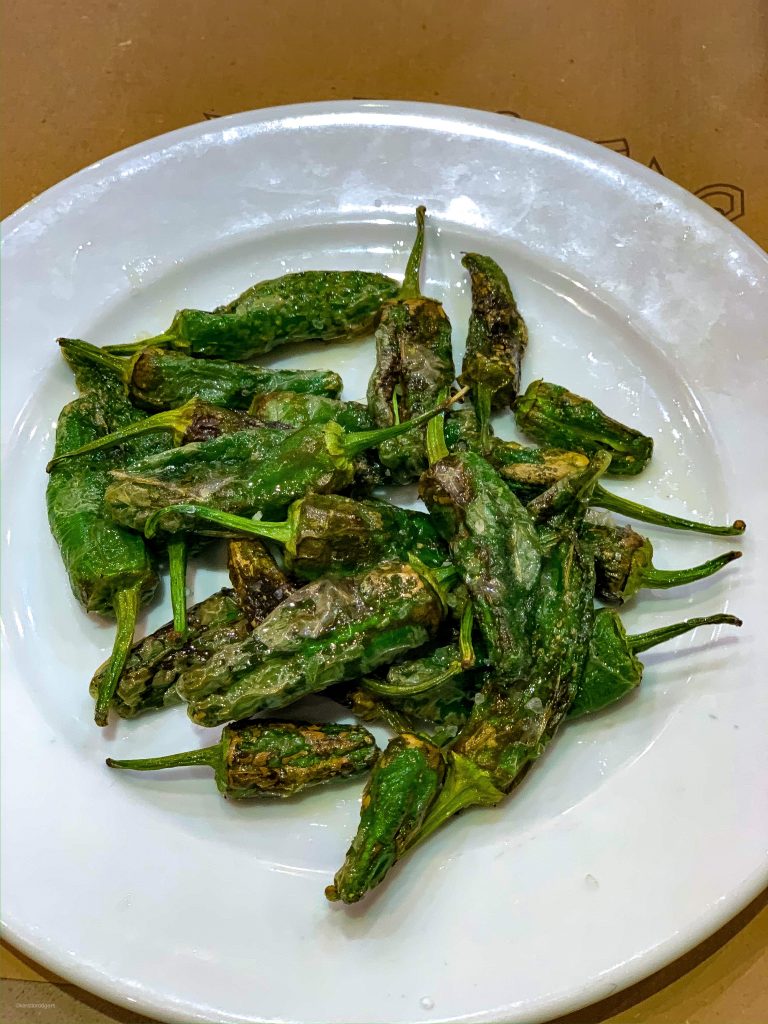






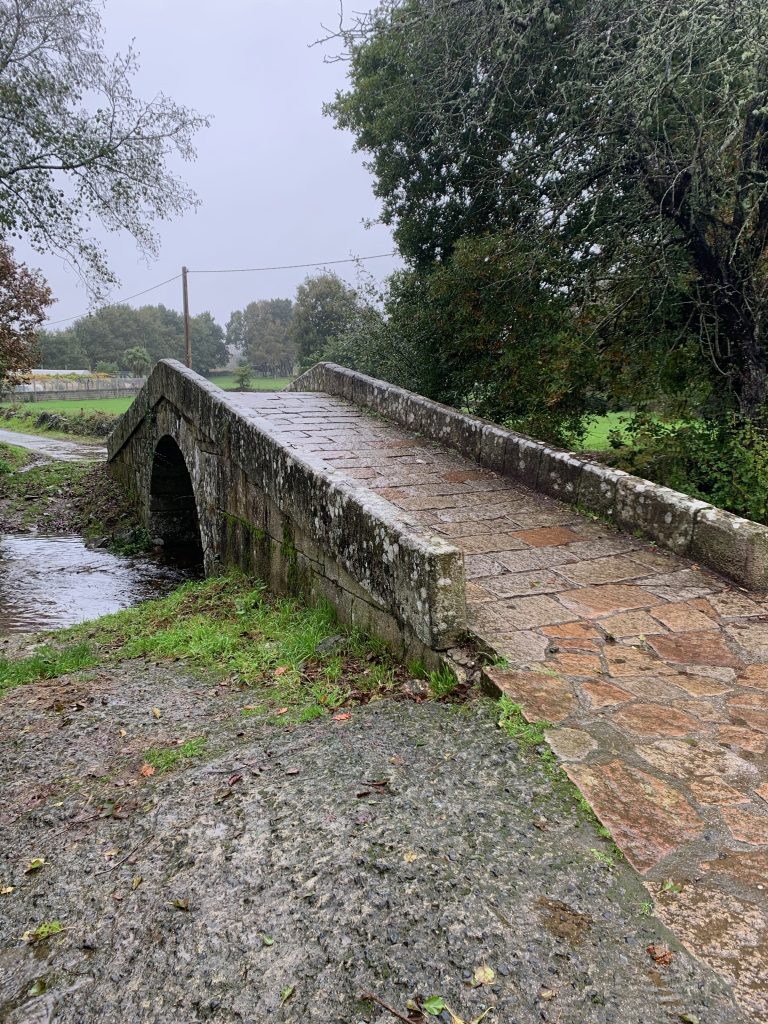



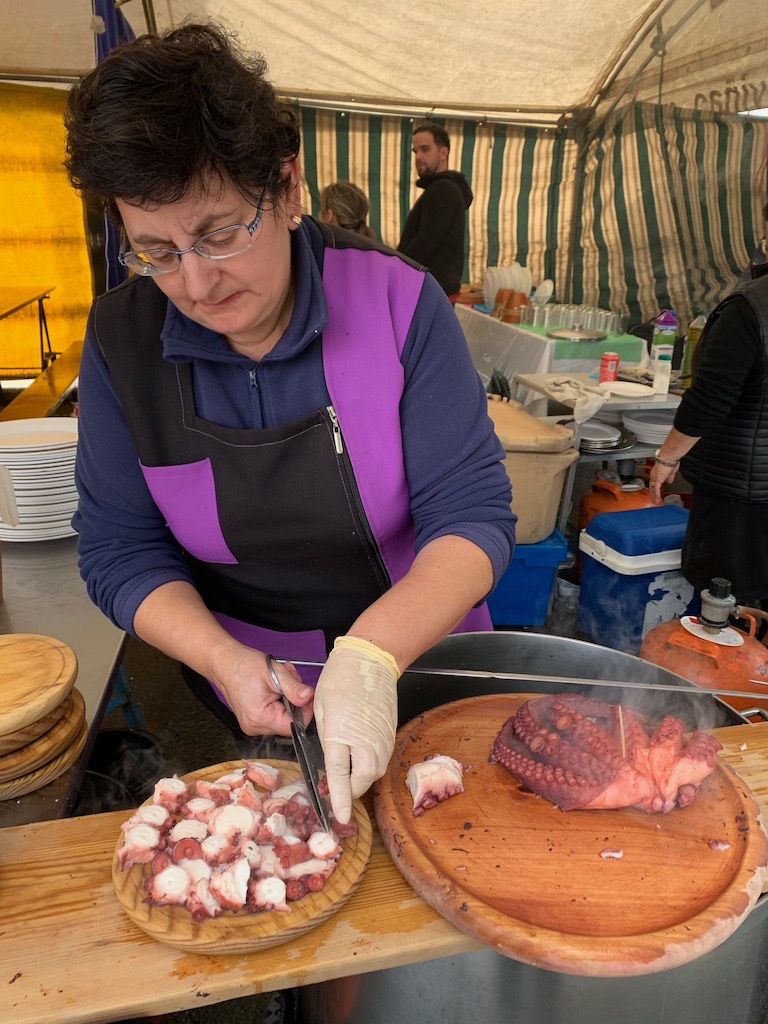
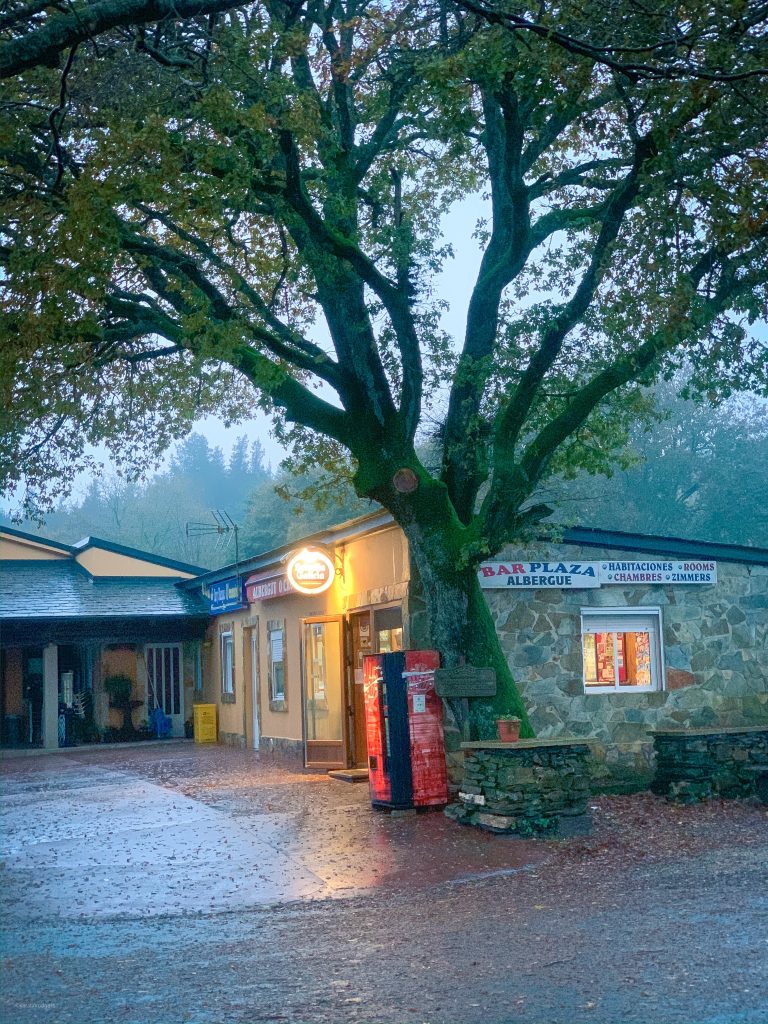

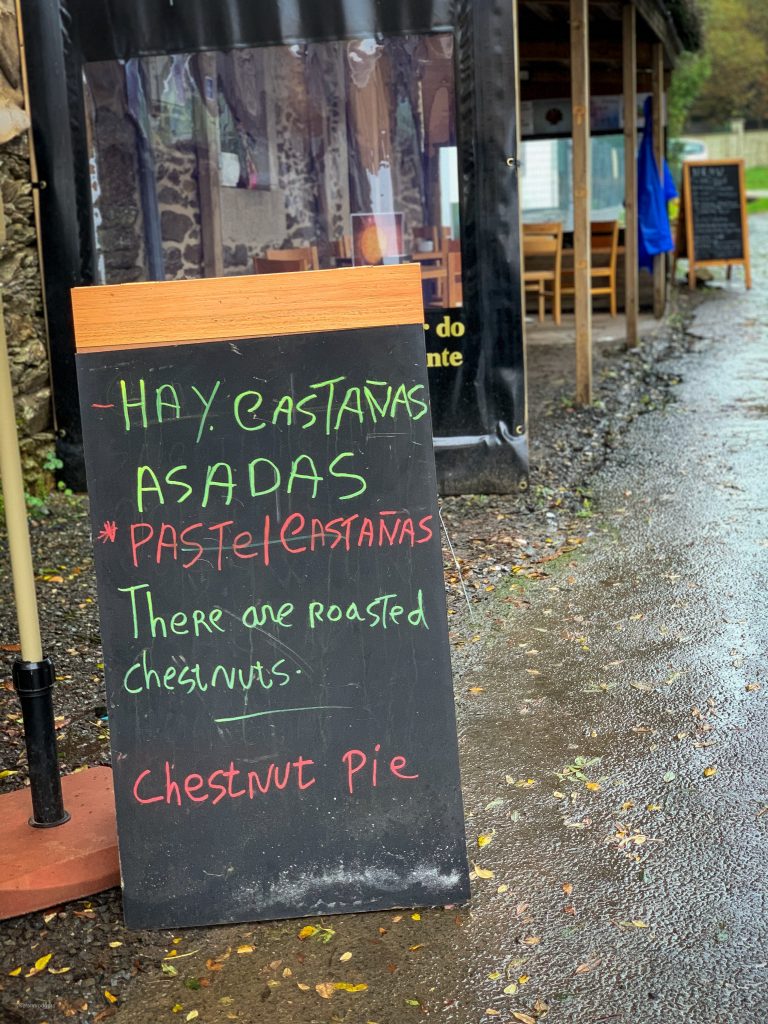




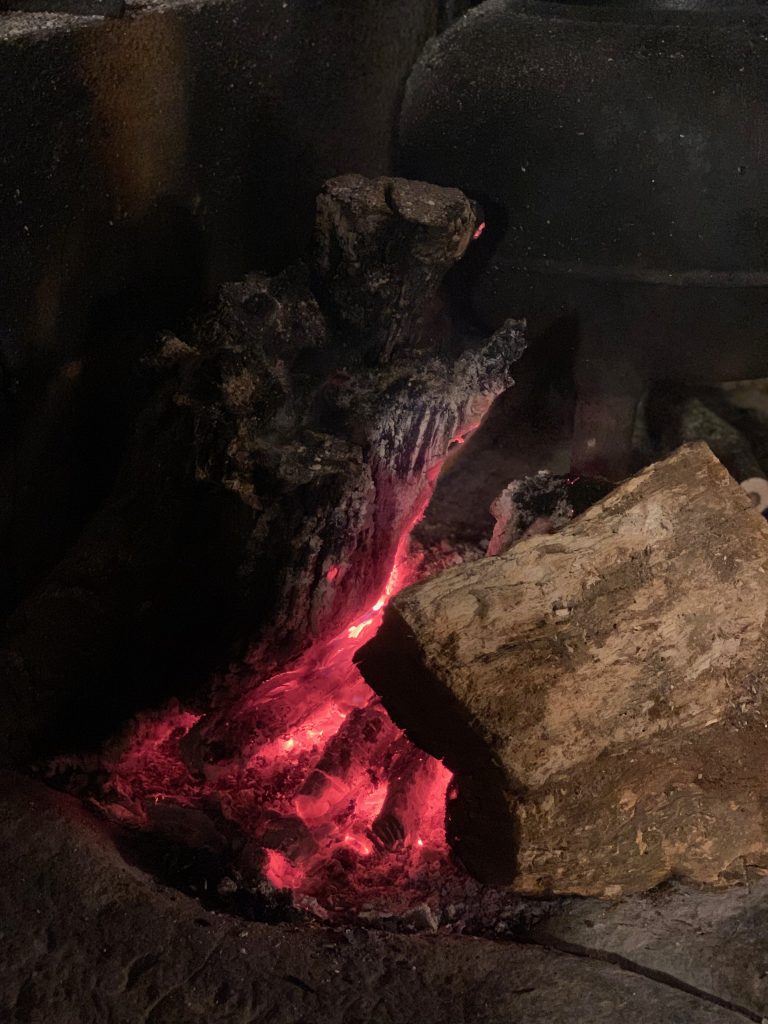














Amazing!
Oh my I just relieved my own experience of the Camino when I was 25. We were doing 35km per day, I don’t know how we did it, but it crippled me then. I recently went cycle touring with my husband, I remember getting to the top of a hill and him saying “come on you can do it”, a few other times I got a “well done, you made it”, why do people think this is helpful? It’s just patronising and it makes it sound like they are the expert and you are in need of encouragement. Like you, I knew I’d make it, I wasn’t worried about getting up a hill even if it was hard because I don’t give up. FFFSSSS!